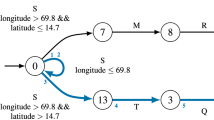Abstract
The problem of interpreting the trajectories of a person (user) moving in a spatial environment is fundamental for the design of any location-based application. We argue that in order to correctly assign a meaning to the spatial behavior encoded by the trajectory, it is necessary to express the meaning in terms of the user’s intentions, more specifically, the goals that the user intends to achieve. Along the trajectory, these intentions will change frequently because the user’s initial goal is decomposed into sequences of subgoals. The paper proposes a representational formalism and a reasoning mechanism for knowledge about an agent who acts according to changing intentions: spatially grounded intentional systems. An objective consists in making the representation as expressive as possible without running into a behavior interpretation problem that is computationally intractable. The approach is shown to be sufficiently expressive to model the interaction between intentions and behavior in a location-based game, CityPoker.
Preview
Unable to display preview. Download preview PDF.
Similar content being viewed by others
References
Abowd, G., Atkeson, C., Hong, J., Long, S., Kooper, R., Pinkerton, M.: Cyberguide. A mobile context-aware tour guide. Wireles. Netwworks 3, 421–433 (1997)
Anderson, J., Lebiere, C.: The atomic components of thought. Erlbaum, Mahwah (1998)
Ashbrook, D., Starner, T.: Using GPS to learn significant locations and predict movement across multiple users. Personal and Ubiquitous Computing 7, 275–286 (2002)
Flintham, M., Anastasi, R., Benford, S.D., Hemmings, T., Crabtree, A., Greenhalgh, C.M., Rodden, T.A., Tandavanitj, N., Adams, M., Row-Farr, J.: Where on-line meets on-the-streets: experiences with mobile mixed reality games. In: Proc. Conference on Human Factors in Computing Systems – CHI 2003, pp. 569–576. ACM Press, New York (2003)
Frank, A., Bittner, S., Raubal, M.: Spatial and Cognitive Simulation with Multi agent Systems. In: Montello, D.R. (ed.) COSIT 2001. LNCS, vol. 2205, pp. 124–139. Springer, Heidelberg (2001)
Hull, R., Clayton, B., Melamed, T.: Rapid authoring of Mediascapes. In: Davies, N., Mynatt, E.D., Siio, I., et al. (eds.) UbiComp 2004. LNCS, vol. 3205, pp. 125–142. Springer, Heidelberg (2004)
Jordan, T., Raubal, M., Gartrell, B., Egenhofer, M.: An affordance-based model of place in GIS. In: Chrisman, Poiker (eds.) Proc. 8th Int. Symposium on Spatial Data Handling - SDH 1998, pp. 98–109. IUG, Vancouver (1998)
Kuhn, W.: Ontologies in support of activities in geographical space. International Journal of Geographical Information Science 15(7), 613–631 (2001)
Laube, P., Imfeld, S.: Analyzing relative motion within groups of trackable moving point objects. In: Egenhofer, M.J., Mark, D.M. (eds.) GIScience 2002. LNCS, vol. 2478, pp. 132–144. Springer, Heidelberg (2002)
Patterson, D., Liao, L., Gajos, K., Collier, M., Licvic, N., Olson, K., Wang, S., Fox, D., Kautz, H.: Oportunity knocks: A system to provide cognitive assistance with transportation services. In: Davies, N., Mynatt, E.D., Siio, I. (eds.) UbiComp 2004. LNCS, vol. 3205, pp. 433–450. Springer, Heidelberg (2004)
Rao, A., Georgeff, M.: Modeling rational agents within a BDI-architecture. In: Fikes, R., et al. (eds.) Proc. of Knowledge Representation and Reasoning – KRR 1991, pp. 473–484. Morgan Kaufmann Publishers, San Mateo (1991)
Schlieder, C., Werner, A.: Interpretation of Intentional Behavior in Spatial Partonomies. In: Freksa, et al. (eds.) Spatial Cognition III, pp. 401–414. Springer, Heidelberg (2003)
Author information
Authors and Affiliations
Editor information
Editors and Affiliations
Rights and permissions
Copyright information
© 2005 Springer-Verlag Berlin Heidelberg
About this paper
Cite this paper
Schlieder, C. (2005). Representing the Meaning of Spatial Behavior by Spatially Grounded Intentional Systems. In: Rodríguez, M.A., Cruz, I., Levashkin, S., Egenhofer, M.J. (eds) GeoSpatial Semantics. GeoS 2005. Lecture Notes in Computer Science, vol 3799. Springer, Berlin, Heidelberg. https://doi.org/10.1007/11586180_3
Download citation
DOI: https://doi.org/10.1007/11586180_3
Publisher Name: Springer, Berlin, Heidelberg
Print ISBN: 978-3-540-30288-9
Online ISBN: 978-3-540-32283-2
eBook Packages: Computer ScienceComputer Science (R0)




